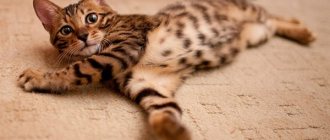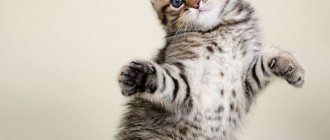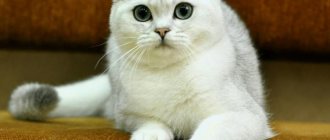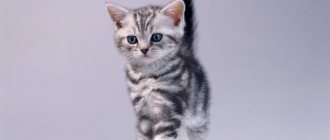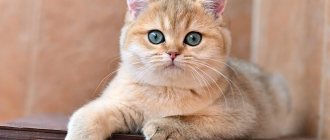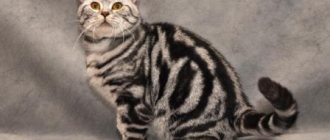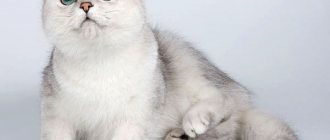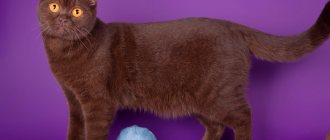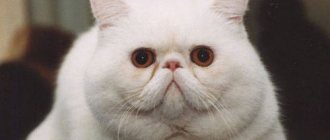History of origin
The name “golden chinchilla” does not mean a breed at all, as many might think, but a color that can be found in more than one breed. Chinchilla animals have a similar color, after which the name appeared.
Chinchilla color - light tone with dark tips
The first kitten was born in the 1880s in England and was silver in color. They called the cat Shinny. The grayish color changed from roots to tips. The roots were light in tone, and the tips were almost black. Parents - domestic cats - had a silver tabby and smoky color. The unique color combined both light and dark notes.
By the middle of the 20th century, kittens with a golden hue began to appear. The color was obtained by mating a “golden” Persian cat and a silver British cat.
The breed received official recognition at the end of the twentieth century.
The Persians and the British took part in breeding new individuals, so the colors come in different colors. Currently, the three main types of the breed are British, Scottish and Persian chinchillas.
One version says that the roots of chinchillas come from Ancient Rome. And the British are a very ancient breed of cats.
Mating, pregnancy and childbirth
To maintain conformation, breeders follow one rule - to breed cats of the same color. That is, gold with gold, silver with silver. Otherwise, the “blurred” color will undergo unsuccessful changes with the likelihood of defects appearing.
To obtain a golden chinchilla color, the breeder must be aware of the genetic predisposition to color in both partners.
In general, mating and pregnancy of Chinchillas does not have breed characteristics. The first mating of females occurs up to 1.5 years, but not during the first estrus. For an inexperienced partner, a more experienced one is selected so that there are no difficulties in the process. Mating takes place during the female's estrus phase, when she herself shows interest in the opposite sex.
Pregnancy in British Chinchillas depends on the weight of the cat. In smaller individuals (up to 3 kg) it lasts on average 56-60 days. Large females (from 5 kg) can give birth in 65 days or later.
British Chinchillas don't give birth to many kittens. Having 6 kids is a huge achievement for them. On average, 3-4 kittens are born in one litter; the birth of only one is not uncommon. However, sometimes milk is still not enough. In this case, supplementary feeding with special cat milk substitutes is recommended.
Description of the Ocicat cat breed, their photos and a story about their character
Before giving birth, it is very important to provide a sterile shelter and a change of bedding, since the cat will release amniotic fluid before the kittens are born. Most often, fabrics serve as bedding - pillowcases, sheets, diapers. It is undesirable to use newspapers - they are unable to absorb liquid and do not eliminate odor.
It is very important to immediately provide the expectant mother with a special feeding regimen for pregnant and postpartum cats. This is the only way to be sure of the good health of the kittens and the pet itself.
In most cases, purebred cats give birth on their own and they expect only moral support from their owners. The most important thing is not to be nervous or worry, so as not to disturb the expectant mother for no reason.
If the owner does not have experience in giving birth to a cat and is afraid, it is better to invite a veterinarian.
Features of the golden chinchilla color
Initially, similar colors were found among Persian representatives of the breed. But now it is also common to other breeds.
A standard chinchilla has a dark tip in a ratio of 1 to 8 of the entire length of the coat. The shaded suit has a ratio of 1 to 3, and the golden tabby color has a ratio of 1 to 2.
Black tips indicate the color standard
Most prefer cats with a smooth golden undercoat without a gray tone at the roots.
The appearance of this color is explained genetically. Three genes contribute to color formation:
- melanin inhibitor – eats pigment from the root;
- tabby - makes a pattern;
- erizer – promotes the warmth of the undercoat shade.
Based on the tips of the fur coat, several varieties of color can be distinguished:
- Black.
- Chocolate.
- Lilac.
- Fawn.
- Cinnamon.
- Blue.
It doesn’t matter what breed the chinchilla cat is, but the main features should be the same: a smooth gradient from a delicate peach shade to dark tips. The color of the undercoat can vary: from light beige to red. But, most importantly, the absence of dull areas on the fur.
Silver or blue chinchillas have a strict color standard:
- Green or blue eyes.
- Strict absence of dark areas on the paws, between the pads of the toes and on the body.
Silver chinchilla
There are also white chinchillas. Almost the entire body is white. Some parts of the body (the paws, the tip of the tail or the muzzle) may acquire a silvery tint.
White chinchilla
Choosing a kitten
British cats are a popular breed. It is known to everyone, even those who do not have extensive knowledge in the field of felinology. Chinchillas are in great demand, especially among those who want to participate in cat shows. Therefore, finding a nursery will not be particularly difficult.
Price
Now a few words about how much such a cat costs. The minimum prices for Chinchilla kittens are 5-20 thousand rubles. A show-class pet will cost 50-100 thousand rubles. However, average prices in the country are standard - 20-30 thousand rubles, both for silver and gold color.
Before purchasing, you need to make sure that the kitten’s parents do not have hereditary diseases. To do this, the future owner can request pedigree and veterinary documents from the breeder.
Appearance
There is no one standard appearance for chinchillas. Animals are assessed according to the standard of a specific breed. As mentioned, there are now three main types. Let's take a closer look at them.
- British chinchilla cats are short, with well-developed muscles. Round, wide head and large cheeks. Widely set small ears with round tips. Thick, slightly bent tail. Dense undercoat. The fur is plush and smooth. There are short-haired and long-haired. The long hair came from the roots of the Persians. The eyes are most often green, but blue- or yellow-eyed individuals can be found.
British golden chinchilla
- Scottish chinchilla has a rounded body, well-developed muscles, short, thick legs. Thick, dense coat of color, like the British. Dense undercoat. There are straight-eared and lop-eared individuals. The second have legs that are slightly shorter and thicker, and the ears are small and downward. Green eyes, sometimes blue.
Scottish fold golden chinchilla
- Persian chinchillas have a more rectangular body with powerful but short legs. The body is slightly smaller than the British or Scottish. Large head and slightly flattened forehead. The Persian coat is long-haired and dense. The shades of wool are the same. The eyes are green or bluish.
Persian golden chinchilla
Silver cats are more often found with yellow eyes.
Males, unlike females, have very large cheeks.
Males have big cheeks
The general characteristics for each breed are as follows:
- Dense and muscular body.
- Short paws with round pads. Pads are black or brown.
- A small skull with a rounded chin.
- Small pinkish and reddish nose.
- Straight fluffy ponytail with a round tip.
- The eyes are green, blue, yellow (depending on the breed), but the most important thing is the presence of black or brown eyeliner around the eyes. Eyeliner can also be used around the nose and lips.
- Pinkish lobes.
Any representative of this color has black eyeliner around the eyes
British chinchilla breed
As its name suggests, the breed originated in Great Britain. But others that originated in other countries were also used in breeding, for example, Persian cats. British cats as a breed were finally formed at the end of the 19th century. But the standard was finally approved only in the 80s of the 20th century. Then work began on developing new colors.
History of origin
The British Golden Chinchilla got its beautiful color by crossing the Persian Chinchilla breed with other breeds that have a solid color, with the British having a smoky coat color.
But the breeders were not satisfied with the eye color of the offspring, which changed from turquoise green to greenish yellow. In order to preserve the original eye color, breeders tried to cross cats with green-eyed tabbies. However, the result was unsatisfactory. For this reason, it was decided to cross the first generation animals with each other, periodically adding Persian blood.
The British golden chinchilla was bred according to the same principles as silver-colored individuals. The difference is that the breed was based on an already bred silver chinchilla. Since the gene responsible for the golden coat color had already been received from the Persian ancestors, breeders only had to fix it.
Material on the topic: everything about the care and maintenance of British breed cats.
Golden chinchilla color.
Character
All representatives of the golden chinchilla have a calm, friendly and peaceful character. They get along calmly with other animals, love to play with children, love affection and stroking. They easily tolerate loneliness, but when meeting their owner they show joy and participation.
However, the British are more capricious, unlike their counterparts. They respect personal space and are more neutral towards affection and excessive squeezing. Very patient. They cannot stay in hugs for long.
The British are more willful and proud
Scots, on the contrary, can follow their owner in search of affection, especially after separation. But they also tolerate loneliness calmly.
Persians can be said to be the most gentle. They love to be the center of attention and can bask in the arms of their owner for a long time. But they don't like other animals. They want to be in first place. Lazier than the British and Scots. They can be stubborn and unpredictable.
Persians are lazy and stubborn
All cats are quite smart and learn quickly. But here, too, the British distinguished themselves by their sharper intellect.
Genetics of color
A polygenic complex is responsible for the golden chinchilla color, providing a warm shade of the undercoat and a lightened background color:
- melanin inhibitor – absorbs hair pigment, starting from the hair root;
- agouti and tabby (tabby) - forms a pattern;
- erizer – gene eraser, gives the undercoat a warm shade.
The golden chinchilla color includes several varieties depending on the color of the hair tips:
- black;
- chocolate;
- lilac;
- faun (fawn);
- cinnamon (cinnamon);
- blue.
The golden color is a recessive trait in relation to the silver color. Kittens of this color can be obtained in the following cases:
- both manufacturers have a golden color;
- parents are silver chinchillas, but are carriers of the golden gene;
- one producer is golden, the second is silver, but his genotype contains genes for goldenness.
Keeping a golden chinchilla
You won't see anything unusual in caring for chinchillas.
The British are very clean and quickly learn to use the litter box. But you need to get used to it from childhood.
The British are very clean
If you want to walk your cat, then accustom it to a leash or harness from childhood. Flea and tick vaccinations are also required.
Accustom your cat to a leash from childhood
There are some nuances in keeping Scottish cats. These little animals are very nasty. Try to keep the room temperature at least twenty degrees.
But Persians, due to their character, can get into unpleasant situations. They can be expected to show sudden activity, such as jumping towards a boiling pot or a full bath of water. They may eat carelessly left behind tablets. Take care of the safety of this pet. What is most interesting is that if the Persian initially chose a place for himself in the house, it does not matter where it will be, whether it is convenient for you or not, but he will not move from this place.
But every cat should have a place to sleep. Animals are unpretentious in this regard. I can even sleep in a cardboard box.
Provide your cat with a place to sleep, a scratching post and toys.
Also buy your pets various toys. They love to play both with you and alone.
Recognized colors of chinchilla cats
Silver chinchilla.
Considered a classic color. Ticking includes white and black colors. In this case, only the very tip (one eighth of the entire length) of the hair is colored black. This creates a spectacular smoky shade.
Silver shaded.
The black ticking is enhanced on the tail and paws. The belly, chest and chin are predominantly white.
Nutrition
There is also nothing unusual in what cats eat. If you decide to feed dry prepared foods, then they should be premium or super-premium. The food contains all the necessary substances and microelements. Sometimes cats can be treated to wet ready-made food.
If you choose natural food, then give preference to the following products:
- Lean meat, poultry or rabbit. The meat can be boiled or scalded.
- Sea fish, fermented milk products, and quail eggs are given a couple of times a week.
- Boiled buckwheat porridge two to three times a week.
You can notice that the diet contains the most protein, then fats, and the least amount of carbohydrates.
You should exclude sweet, smoked, spicy, salty foods, as well as raw milk.
With a natural diet, it is recommended to give additional vitamin complexes.
The most important thing, regardless of the type of diet, is the availability of fresh and clean water.
The breed is prone to overeating and obesity
These animals are prone to obesity, especially Persians due to their laziness. Animals do not know what to eat in moderation. Adults are fed no more than three times a day. Small kittens for growth and development - six times.
Feeding the animals
For feeding golden chinchillas, like other purebred cats, high-quality ready-made food with a protein content of at least 30-35% is suitable. They have a balanced composition and fully satisfy the needs of the animal’s body.
The following brands have proven themselves well:
- 1st Choice;
- Hills;
- Acana;
- Leonardo;
- Sanabelle Bosch;
- Pro Plan.
If the owner chooses a natural diet, then it is based on meat - turkey, chicken, veal. The meat needs to be frozen for 2-3 days. It is given raw, cut into pieces and doused with boiling water. These measures are necessary to destroy parasites and bacteria.
Cats do not refuse offal. Liver, lung, heart, tripe are suitable for feeding. They must be boiled for several hours.
Also included in the diet:
- rice and buckwheat porridges;
- boiled sea fish fillet (if you have problems with the genitourinary system, this product is excluded);
- boiled vegetables (zucchini, carrots, pumpkin, cauliflower);
- egg yolk (no more than 2 times a week);
- fermented milk products with low fat content (kefir, yogurt, cottage cheese, natural yogurt).
Pets are fed 2-3 times a day. Food from the human table is contraindicated for animals.
Appearance care
Short-haired individuals do not require frequent brushing, only once every two weeks. Those with long fur require more frequent brushing and tangle removal. The procedure is best performed using a furminator.
Persians need brushing more than other breeds.
All representatives need to clean their eyes with a cotton swab as they become dirty and their ears with a cotton pad. You can moisten it with warm clean water or chamomile infusion.
Scottish Folds need special care for their ears. Due to the structure of their ears, this breed is more susceptible to dirt accumulation and infections.
The claws are trimmed once a month, removing only the very tips. A scratching post can handle daily grinding.
Animals need to be bathed with a special shampoo for shine and thickness once every three months. Their fur does not get dirty quickly. If your cat really doesn't like water, you can use dry shampoo.
To avoid tartar, cats should brush their teeth with an individual brush and toothpaste. Special feeds are sold for the same purpose.
How much does a royal chinchilla cost?
Pure golden color is quite rare. More often you can see kittens having the so-called halftone. In the metrics that are issued at 1.5 months, they are often noted as golden chinchillas. But after molting, which takes place in 5-8 months, the color changes.
For people who have a kitten as a pet, these nuances do not matter. But for those who breed or plan to participate in exhibitions, color purity is very important.
To avoid misunderstandings, you should:
- carefully study the requirements for color and its features;
- read reviews about breeders offering such animals;
- meet the kittens’ parents and evaluate their compliance with the standard.
Due to the difficulty of obtaining a color, a kitten is quite expensive:
- British chinchillas: pet class - 25 thousand rubles, show class - about 50-70 thousand rubles;
- Scottish and Persian cats: pet class - 12-25 thousand rubles, show class - from 35 thousand rubles.
Purebred kittens can be purchased at a specialized nursery or from a reputable breeder who breeds animals of this particular color.
Important. Finding a rare pet from an ad on the Internet is almost impossible. Chinchillas are bred only through competent breeding work.
There is a common misconception that there is an independent breed of golden chinchilla cats. Because of this, confusion often arises. For example, people who count on an easy-going Briton end up with wayward Scots. Therefore, it is so important to first find out all the nuances, and only then get a pet.
Golden chinchilla cats are very rare, unusually beautiful and intelligent animals. These are real fluffy “suns”, a find for lovers of luxury and chic.
Possible diseases
Chinchillas have a fairly good immune system, but, unfortunately, they are prone to some genetic diseases:
- Retinal atrophy.
- Polycystic kidney disease.
- Caries.
- Hypertrophied cardiopathy.
To avoid typical diseases typical of any cat, it is necessary to be vaccinated against rabies, calicivirus, and rhinotracheitis.
In addition to diseases, cats may have appearance defects:
- Thin cheeks.
- Pit on the nose.
- Rare fur.
- Strongly elongated muzzle.
- Flat forehead.
- Deafness, blindness.
- Deformed skeleton, teeth, jaws, eyelids.
Such shortcomings exclude the participation of animals in exhibitions.
Color point
The “color point” color was originally found only in Siamese cats. However, over time it spread to other breeds, including chinchillas.
Longhair black silver veiled color point BLH ns 12 33
Black silver shaded color point BRI ns 11 33 with blue eyes
A sign of this color, regardless of whether the cat belongs to a particular breed, is blue eye color. Thus, blue-eyed cats appeared in the community of green-eyed chinchillas.
ns 11 33
ns 12 33
Breeding
Breeding handsome dogs is quite difficult. Only professionals can achieve the desired color.
Golden kittens can be obtained by the following matings:
- Both parents are golden.
- The parents are silver, but have “golden” genes.
- The male (female) is golden, and the partner is silver, with the golden gene.
If you plan to participate in exhibitions, then both parents must be purebred breeds and colors. There must be no genetic pathologies. Each parent must have all the necessary documents (passport, pedigree and permission for mating) and be vaccinated.
Breeding kittens is a very complex procedure
Cats of this breed mature late. It is best to start mating between the ages of one and a half to two years. The break between matings should be at least 4 months so that the body has time to recover. It’s better to limit yourself to once or twice a year. Pregnancy of cats lasts from 56 to 70 days.
If your pet has given birth to kittens, contact the organization to identify the breed and obtain a passport. This way you can officially sell kittens.
The presence of a pedigree can provide insight into the complete characteristics of the pet. Letters and numbers will show information about the animal.
Breed: BRI - British; PER – Persian; SFL – Scots Fold Shorthair; SFS – long-haired Scots Fold; SCS – Scots with erect ears, shorthair; SCL – long-haired, erect-eared Scotsman.
Color: y – golden; a – blue; b – chocolate; c – lilac; n – black; o – cinnamon; q – faun.
Drawing code: 11 – shaded; 12 – chinchilla; 21 – tabby.
At the end they put numbers indicating eye color: 64 – green; 61 – blue; 62 – yellow.
Maintenance and care
A characteristic difficulty in keeping chinchilla cats is combing out their thick fur. The coat, although not long, has a very dense undercoat. In order for a cat to have a representative appearance, its fur needs to be brushed with special puppies. During the period of intense molting (on the eve of winter), this must be done daily.
It is best to feed purebred British chinchillas with special food, in which the manufacturers have already calculated the balance of all nutrients.
If the owner of such beauty prefers natural food, chicken fillet, fish (without entrails, scales and bones), low-fat fermented milk products, washed fruits and vegetables are recommended. Meat and fish must undergo heat treatment. There should always be a bowl or water bowl with clean drinking water in the cat's kitchen.
Before you buy a golden chinchilla cat, you need to equip it with a place to play and sleep. This could be a special cat corner with shelves and houses covered with thick fabric, as well as a soft bed.
The pet should have a claw sharpener freely available - the British chinchilla is of too noble blood to spoil furniture, but its claws grow as quickly as those of ordinary cats. They need to be trimmed and ground down.
All pets should undergo routine examinations by a veterinarian – chinchillas are no exception. Kittens receive several vaccinations when obtaining a veterinary passport. This is usually done by the breeder. However, then the owner must update vaccinations at least once a year.
Even if the cat does not go outside, she regularly needs to be given deworming tablets (you can buy them at a veterinary pharmacy, given by weight), examine and clean the ears, and monitor the condition of the eyes and mucous membranes. In growing kittens, attention is paid to changing teeth - if difficulties arise, you should immediately go to the veterinarian.
Advantages and disadvantages of the breed
The advantages of the breed include:
- Original, beautiful appearance.
- High intelligence.
- Lack of aggression.
- Restraint and patience.
- They tolerate loneliness calmly.
- They love their owners.
Flaws:
- Stubbornness (especially among Persians).
- Difficulty in breeding.
- Excessive pride.
Cats are very proud and value space.
Character and behavior of elite pets
Chinchillas are considered the aristocrats of the cat family. They are distinguished by noble manners, a sharp mind and excellent memory.
The characteristics of golden chinchilla cats are determined by the breed:
- British are balanced and reasonable animals. They are characterized by patience, silence, and lack of desire to cause mischief. Owners note that the Golden Briton is more people-oriented. He needs the attention of his owner, but does not suffer from excessive intrusiveness. This is a good companion who loves children, follows the rules of living together in an apartment, and travels with pleasure.
- Scottish cats are capricious and curious pets that often meow and are excessively intrusive. But at the same time they are playful and friendly. They tolerate loneliness quite well if they have a variety of toys at their disposal.
- The Persian is an obedient cat. She can be overly touchy, but quickly forgets troubles. Quite lazy, but during play or hunting she is very active. Although outwardly unperturbed, she may suddenly jump onto a hot stove or perform some other unexpected action.
Each animal has individual character traits. Therefore, the habits and behavior of pets may differ slightly from the description given.
Purchasing a kitten
You should buy kittens only in specialized shelters or from professional breeders, otherwise you can become the owner of a non-pedigreed animal or an animal of a different breed altogether. Also, a cat may have diseases that are invisible to the eye. Golden chinchilla kittens must have all documents, pedigree, veterinary passport, vaccinations.
The price depends on compliance with the breed standard. Pet-class pets cost from ten thousand rubles. Breeding and show classes are much more expensive. They are more thoroughbred and meet show standards. Prices can reach forty thousand rubles. The British and Scots are more expensive than the Persians.
The price of kittens depends on the standard color and breed, which will be determined by specialists
Do not forget that the “golden chinchilla” is a very beautiful color, and the breed of cats can be different. But still, these breeds have an unusual “golden” appearance. Pets will delight their owners with their appearance and calm character.
Advantages and disadvantages
The most important advantage of Chinchillas is their unique coat. Visually, it gives the appearance of a fluffy and plush cat. Their special color is the result of long and complex selective work, thanks to which the chinchilla variety has fans all over the world.
A balanced character is also one of the advantages of the breed. This pet is ideal for life in a big city. At the same time, the owner need not be afraid that the pet will be bored during the period of separation. The British are not afraid of loneliness and feel calm when surrounded by a large family.
The main disadvantage of Chinchillas is their stubborn nature. The owner may encounter his ward’s love of freedom. The pet will not do what it does not want even under pressure. Therefore, the owner must begin the educational process almost from the first days of the kitten’s appearance in the new home.
Predisposition to diseases
The British Shorthair has a long history, and one of the results of meticulous selection is that these animals have excellent health and excellent disposition. This is a long-lived breed. However, due to crossbreeding with Persian cats, some members of the chinchilla variety sometimes have kidney disease, although this is not common.
Polycystic kidney disease and blood type B
In the 20th century, British Shorthair breeders used Persian cats to create a chinchilla line.
Persians are prone to an inherited kidney disease called polycystic kidney disease. Since then, outbreaks of this disease have been periodically reported in the UK. A more common problem for British cats is the rare blood type that some of these cats have. British Shorthairs can be Type A or Type B. Most have Type A blood. Some have Type B. It is not a blood disorder, and Type B cats are just as healthy as Type A cats. But for breeding purposes or if blood transfusions are needed this must be taken into account. Type A blood will kill a cat with type B blood and vice versa. British shorthair breeders are worried about blood type due to "fading kitten" syndrome. When the mother cat has type B blood and the father of the kittens has type A blood, their kittens can have both type A and type B blood. Mother's milk contains antibodies to type A, which will kill type A kittens within 72 hours. Fortunately, there is now a DNA test to check the blood type before breeding a cat.
Health
Description of how to properly care for a chinchilla. This is the key to the longevity of a pet. However, the breed from birth has a predisposition to :
- hypertrophied cardiomyopathy;
- obesity;
- retinal atrophy;
- polycystic kidney disease.
Sometimes there are problems with the respiratory system, teeth, and skin diseases. The cat must be vaccinated from the first months of life. Mandatory injections for a number of diseases are given annually.
Description and requirements for the standard
Despite the differences in color, the British chinchilla cat, regardless of the color of its coat, has a unique body structure. Representatives of this elite breed are characterized by large round eyes, pronounced cheeks, dense coat texture and a medium-sized head with small, rounded ears. Chinchillas have a short and wide nose.
As for the build, the chinchilla cat is distinguished by its medium body size, squat shape, flat back and powerful short paws, on which there are tufts of hair between the toes. The tail is short in length.
According to accepted standards, the color of a silver chinchilla is white with darkened edges, which creates the effect of the presence of silver on the animal’s fur. Due to the slight covering of black fur, it appears that the cat is wearing a black veil that extends to the back, paws and tail.
- The coat of the rodent of the same name is of medium size, in contrast to the fur coats of the British, which are shorter and fluffier.
- The head is round with small ears.
- The body is strong and wide. The tail is half shorter than the body.
- The paws and nose are short and wide. The nose is light brown and slightly flattened. Despite the general similarity of all individuals, there is a difference between cats with a silver chinchilla color, it is indicated by the amber color of the eyes in some animals.
- All representatives of the species have large, round eyes.
Social structure and reproduction
Photo: British Golden Chinchilla kitten
It is recommended to breed animals by professionals who have experience in this field. The British Golden Chinchilla is bred mainly in specialized nurseries. Before breeding cats at home, you should study the intricacies of this matter. Zoologists warn that this breed is not fully formed. During mating and pregnancy, cats need special care and attention. The first step is to take care of choosing suitable partners for breeding.
Criteria for selecting partners:
- the presence of all the characteristics characteristic of this breed in candidates for mating;
- absence of diseases and hereditary pathologies;
- healthy appearance;
- activity;
- availability of all necessary documentation;
- availability of a vaccination passport and all vaccinations in it.
Golden chinchillas are characterized by late development. It is recommended to get them at a time when they become independent, can go to the toilet on their own and eat adult food.
